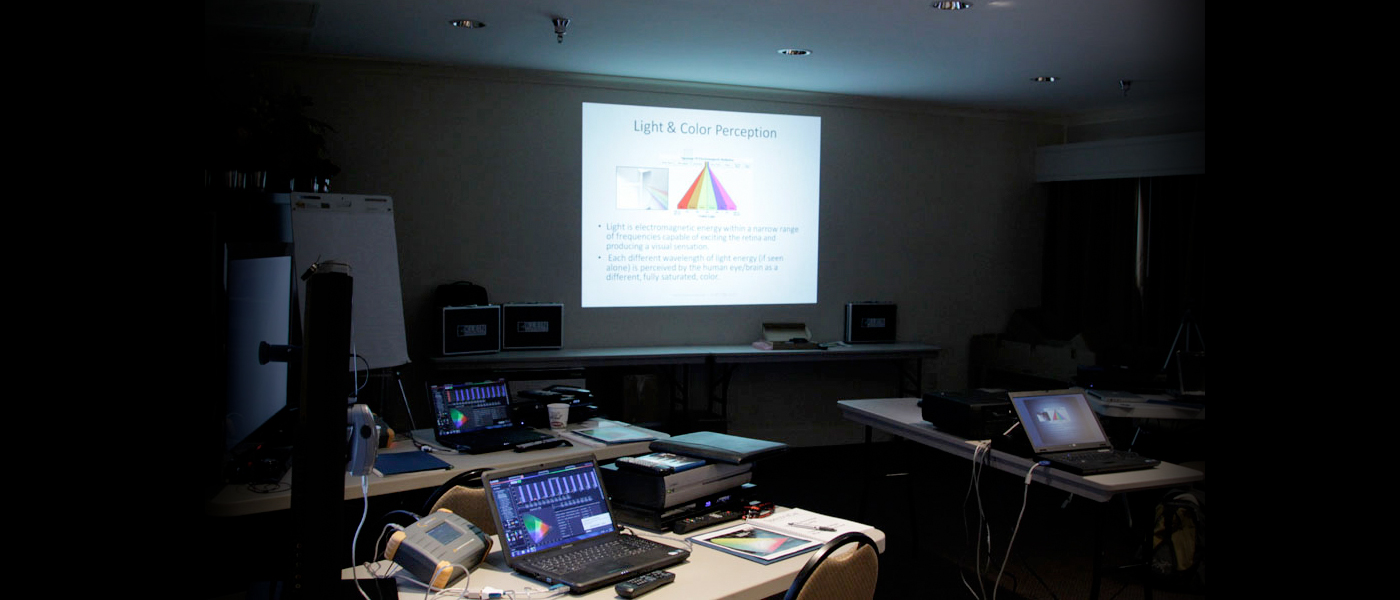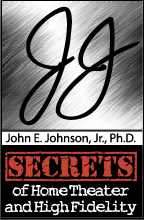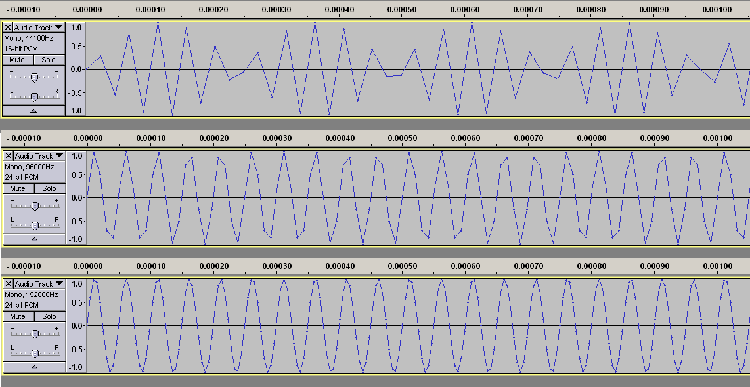We all have heard about the vinyl renaissance, but I just did not realize how strong it is. I mean, LPs are being played everywhere at hi-fi shows. So, we decided to compare Vinyl LPs to CDs in terms of the recording process, manufacturing, and the sound. Parts 1-5 www.hometheaterhifi.com/technical-articles-and-editorials/technical-articles-and-editorials/a-secrets-technical-article63.html (Part I: Introduction, Part 2: The Technology, Part 3: Turntables, Tonearms, and Cartridges, Part 4: The RIAA Curve, and Part 5: Setting up the Turntable) are published in a previous article. The article you are looking at now contains Parts 6-9.
The frequency response of an LP is about 10 Hz to 25 kHz, and it has a dynamic range of 75 dB. All the information is contained within a groove about 0.002″ in width.
This groove is originally cut in a lacquer-coated aluminum disc using a cutting head with a sapphire stylus about 0.0002″ in diameter (10 times smaller than the groove that is cut). Sapphire (a.k.a, corundum, which is the crystalline form of aluminum oxide) is actually better than diamond for cutting the original master, although diamond is better at playing the LPs at home. The cutting head is driven by stereo power amplifiers of about 400 watts each. So, cutting the master is the opposite of playing the recording once it is on the platter that you purchase. The diamond stylus that you play the records with is about 0.001″ across.
A negative replica is made from the master, and then vinyl biscuits are melted on the negative, cooled, trimmed, and packaged for the consumer.
When the technology moved forward from cylinders to discs, it was calculated by Emil Berliner (inventor of the Gramophone) that 78 RPM would reproduce the frequency response using a steel needle. The 33-1/3 RPM speed was developed because the disc used for sound in early movies would hold 11 minutes of the soundtrack, which was the length of one movie reel. Then CBS applied that rotational speed for commercial music recordings and we had the LP with 30 minutes of music on each side of the disc.
Secrets Sponsor
The 45 RPM disc may seem to have been just for the popular music crowd, with two hit songs on each disc, but it was actually a technological advancement in sound quality as well, and in fact, current re-releases of LPs are sometimes in the 45 RPM format, with the music that was originally on two sides of one disc, now on two sides of two discs. I obtained a few of these and will discuss them later in comparison to the more conventional 33-1/3 RPM discs.
The LP was introduced in 1948, and stereo LPs soon followed. They were manufactured from polyvinyl chloride, which was sure a big improvement over the older 78’s made from shellac (much lower surface noise). You could drop them without breaking them, but they were (are) just as sensitive to scratching, and of course, they didn’t (don’t) do well if left in the sun (they warp).
The stylus tip follows the groove at 33-1/3 RPM, which means a linear velocity. The problem (Problem 1) is that the linear velocity changes, because the diameter of the spiral is smaller at the center of the disc than at the outer edge. This is one reason some high-end LP re-releases are at 45 RPM. With the smaller spiral diameter, the high frequencies are crowded into a smaller linear space, and they suffer.
The groove itself is like a “V”, with the right channel being represented by sharp peaks and valleys on the outer edge of the V, and the left channel on the inner edge. So, the stylus, following the groove, is raised on the peaks, and lowered in the valleys. The stylus is connected to the cantilever, and the cantilever has either the coils (MC) or magnets (MM) attached to it, which moves, and induces electrical current in the coils, which is translated into the music through the amplifiers and speakers.
Secrets Sponsor
Stereo grooves could have used a lateral motion for one channel and vertical motion for the other, but it would have resulted in less compatibility with monophonic cartridges, and also, the lateral motion channel would have had lower fidelity than the vertical channel.
Problem 2: The stylus is attempting to translate both channels at the same time, and because the movement of the stylus shares some common direction (the stylus moves downward for both left and right channels), there is some bleeding of each channel into the other, called “crosstalk”. In fact, channel separation is “only” about 30 dB. In other words, if you had a groove where there was a 1 kHz sine wave recorded only in the left channel, and you played it back at 100 dB from the left speaker, you would also hear that sine wave in the right channel at 70 dB.
That number doesn’t sound very good at first glance, but with each 10 dB increase, it sounds (subjectively) twice as loud, and with each 10 dB decrease, it sounds 1/2 as loud. So, going from 100 dB to 90 dB cuts the loudness by 1/2, then to 80 dB is another 50% reduction, then to 70 dB is an additional 50% softer, for a total of 8 times softer at 70 dB. Nevertheless, there is substantial crosstalk with the stereo phonograph recording. CDs, by comparison, have no crosstalk generated by the medium itself. The two tracks are discrete. Any crosstalk is generated by the downstream electronics after the signal is converted from digital to analog. However, that crosstalk is still much less than the crosstalk from tracking an LP groove.
How do you like the problems with LPs so far? Here’s another one. Problem 3: Because the translation of the sound from the groove to the stylus requires that the stylus be falling into the valleys or pushed up with the peaks in the groove, having a out of phase information in the left vs. right channel causes some issues with the laws of physics. In other words, if there is a valley in the left channel at the exact same time there is a peak in the right channel, the stylus finds it a little difficult to be going in opposite directions at the same time. The result? Inaccurate signal reproduction at that instant in time. So, LPs cannot handle a lot of material that is out of phase between the left and right channels.
There were some technology improvements made during the 1980’s, such as the method of disc cutting (making the master disc that would be used to produce the vinyl copies that we purchased). Although the CD began to eclipse the LP in that same decade, we can certainly benefit from the new LP cutting technology that was developed at that time, and which has continued to improve, by going back and remastering (recutting) early classic recordings. Such remasterings and re-issues are now popping up all over the place. Some rock groups, whose musicians were only babies when the CD was introduced, insist in their contracts that their albums be released both as CDs and LPs.
Why, then, if there are these obviously serious problems, do so many people feel the LP sounds “better” than the CD?
Dynamics may be one reason. Along with digital music reproduction, came the ability to mix and edit the music digitally, and this offered incredible flexibility. Boom boxes proliferated, and these boxes didn’t have much in the way of dynamic capability, so CD producers compressed the dynamic range, boosting the quiet parts of the music and attenuating the level of the loud passages. That way, consumers could hear every part of the music, with it all having about the same level of loudness. Although this worked for boom boxes, the music sounded terrible on good audio systems.
Not all companies compressed the dynamics on their CD releases. Telarc is notable here, producing early CDs that, even today, are just marvelous.
In my tests, comparing an LP version of a recording to its CD or SACD counterpart, I have not found dynamics to be an issue at all. In fact, the CD and SACD have the potential to record a higher dynamic range than the LP (LP has a dynamic range of 75 dB, CD has 96 dB, SACD has 120 dB, DVD-A has 144 dB). The problem is that CDs and SACDs have not truly exploited that potential.
Some have said that it is the extended frequency response that LPs have, but SACD has a very high frequency response, at least as good as LP. However, because of filters that are used in playing back digital recordings, there is phase shift that causes problems in the audible high frequency range, and my initial impression is that it is the high frequency area of an LP that has better definition than its digital counterpart.
Well, if the idea is that analog all the way gives the best sound, then why not just go back to playing analog recordings on cassette tapes? The problem there is that the tape speed is so low, the dynamic range is only about 60 dB. Plus, you have tape wear, tape hiss, and the inconvenience of having to rewind or fast forward to get to a particular song.
OK, so now that we have all the preliminary discussion in place, let’s do some measuring.
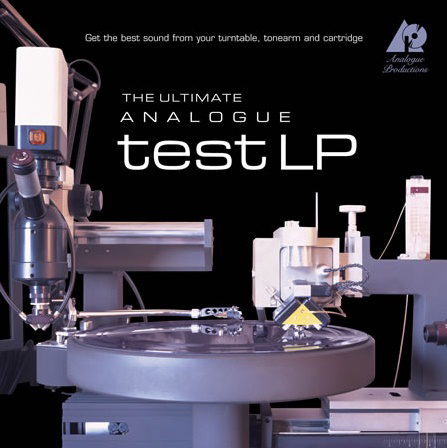
For these initial tests, I used a McIntosh MCD201 SACD/CD player, McIntosh MT10 Turntable with factory cartridge (made by Clearaudio), and a Manley Steelhead phono stage. I connected the analog output of the MCD201 and the Manley Steelhead directly to our Audio Precision SYS-2122 analytical instrument. I used a CD with test tones recorded at – 5dB and a test LP called the Ultimate Analogue Test LP.
To start, I used 1 kHz sine waves.
Here is a graph of the spectrum generated from the test CD. THD+N was 0.005%. That is very low and very good. Notice that the one distortion peak visible is third order.
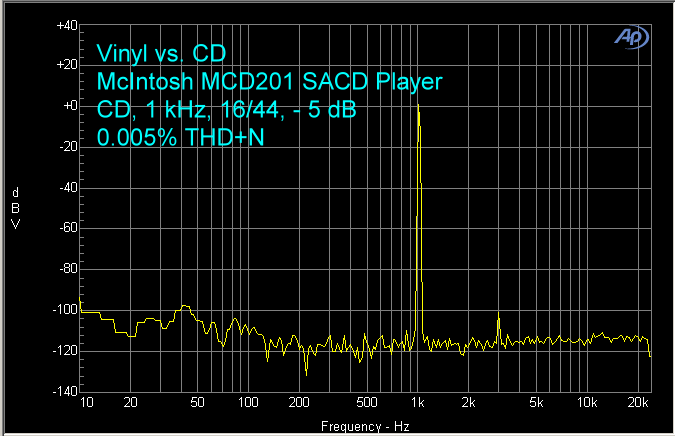
At 10 kHz, distortion rose to 0.01%. Again, the one visible peak is third order.
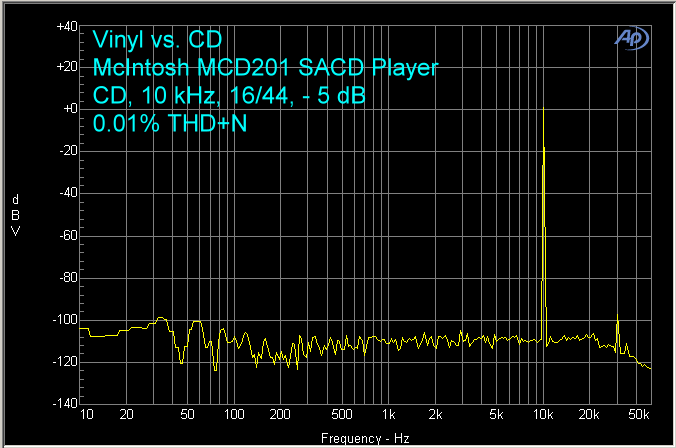 And…(drum roll)…here is what you have been waiting for: The Vinyl Results.
And…(drum roll)…here is what you have been waiting for: The Vinyl Results.
At 1 kHz, 0 dB, distortion was 7%. “Wow, that’s a lot of distortion,” you say. You bet it is, but notice that it is nearly all second order. Also, the noise level contributes to this high number. At best, the noise is 70 dB below the signal, whereas with the CD test, it is more than 100 dB lower. We could measure just the THD, but much of the harmonics are buried in the noise, so this would not be a fair estimation of the resulting sound. However, for the sake of just comparing the distortion peaks to my previous tests of other products, I would estimate the THD to be about 1%.
For this particular graph, I set the “load” for the cartridge at 25 ohms.

Here is the same test, but with the cartridge load set to 400 ohms. THD+N went up a bit, but in this case, I think the distortion peaks were a bit higher, while the noise floor improved. This is why seeing the spectrum is so important. The numbers indicate the overall sum of everything, while the graph shows you where the numbers are coming from. Notice that the primary distortion peak is second order.
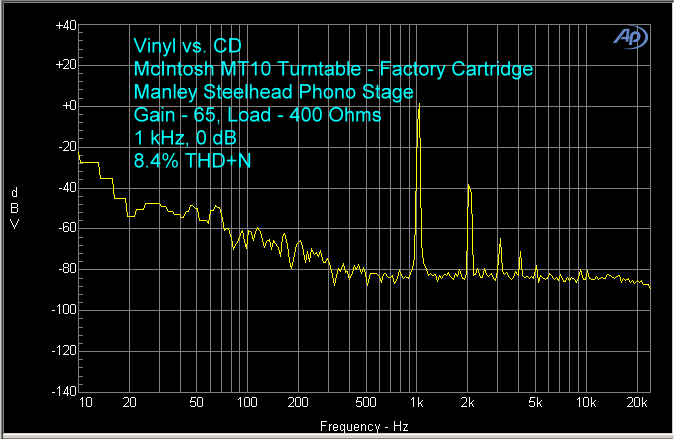
For 10 kHz, I kept the 400 ohm cartridge load. THD+N was a very high 20%, but again, the noise level contributes significantly to the number. Notice that the only visible distortion peak is second order.
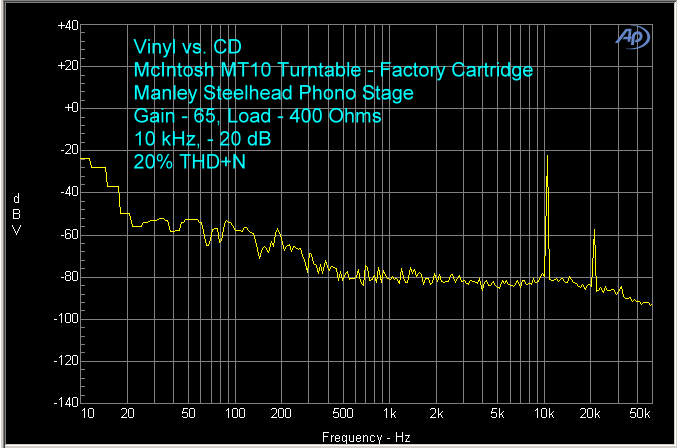
So, what can we say at this point? It seems to me – and this is with some of the very best hi-fi components in the world – that one of the most significant reasons vinyl aficionados love the LP sound is that the distortion is very, very much like that in Pure Class A triode single-ended tube amplifiers. There is a lot of distortion, but it is virtually all second order (even-ordered), which is euphonic, meaning that it is pleasing to the ears. Now, keep in mind that the distortion seen here for the CD is from a superb CD player. If you look at various lower cost CD player reviews out there, you will see more higher order distortion peaks, with odd-ordered peaks closer in level to the even-ordered peaks. Bottom line is that CD has much less distortion, but more of it is odd-ordered, while vinyl has more distortion, but it is euphonic second order.
Now it is time to talk about a very important part of the signal path in playing LPs: The Phono Preamplifier (also called Phono Stage).
For our first look into the phono preamp, I chose three: Musical Surroundings Phonomena, Bryston BP-1.5, and Manley Steelhead, all of which are reported on here. Future cartridge, phono preamp, and turntable reviews will be published in our regular product review section.
(the lowest priced of the three) which is manufactured and marketed by Musical Surroundings, located in Northern California.
At $999, this appears to be a bargain, because it has a lot of features including:
- Built-in automatically charging NiMH battery pack that powers the preamplifier and which disconnects from the AC supply whenever it is in operation.
- Adjustable gain – in 13 steps – from 40 dB to 60 dB.
- Switch for MM vs. MC cartridges (MM cartridges are voltage sources while MC cartridges are current sources).
- Adjustable resistive loading (resistance) – in 17 steps – from 30 Ohms to 100 kOhms.
- 300 pF (pico-Farads) capacitive loading switch, either on (300 pico-Farads) or off (200 pico-Farads).
Here is a photo of the Phonomena’s front panel.
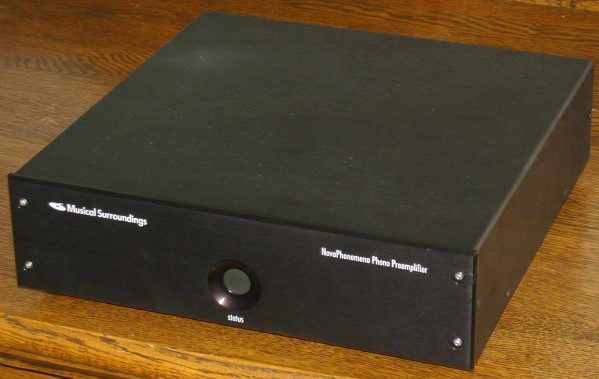
There is no on/off switch, as the Phonomena is meant to stay connected to the wall-wart power supply which keeps the battery pack charging at all times except when you are using it. The status window glows flashing red when it is charging, steady red when it is connected to the wall-wart while you are using it (a situation where the battery pack was not fully charged when you need to use it), and green when it is in use (internal relays disconnect the preamp from the wall-wart charger, you don’t have to physically unplug it).
The rear panel has all the necessary jacks and switches (click on the photo to see a larger version). To turn it on, you simply touch the red status window, and it will change to green. You will hear the relays inside disconnecting from the wall-wart power.
Besides the RCA input and output jacks, each channel also has its own set of dip switches to select the gain, resistance, and capacitive load. The jack for the wall-wart cable is on the right.

So, when you turn the Phonomena on, there is only low voltage DC anywhere in the circuit. Because phono preamps have to deal with very, very low level signals (0.3 mV up to 5 mV), this is important.
I tested the Phonomena with a VPI HR-X turntable (we recently added this turntable so we can compare cartridges in future reviews, using the McIntosh MT10 with its superb MC cartridge as a reference), Sumiko Blackbird MC cartridge ($799, 2.5 mV output, 2 gram recommended tracking force, 135 ohm internal impedance, i.e., DCR or DC Resistance of the coils that will drive a 47 kOhm input on an MM phono stage if you didn’t have a preamp with an MC input), BAT VK-5i preamplifier, McIntosh MC1201 power amplifiers, and Carver Amazing speakers. Cables were Nordost, Legenburg, and various others.
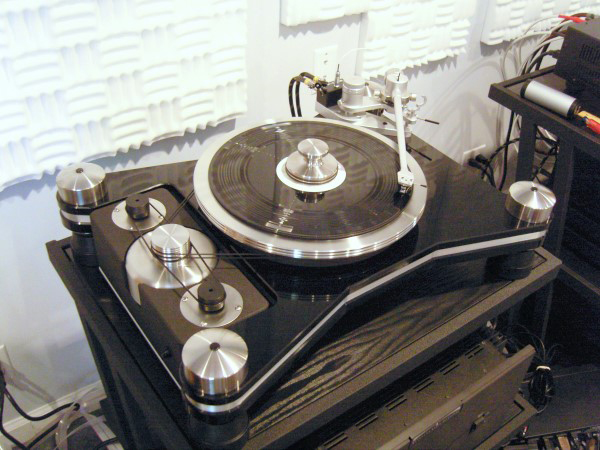
The Phonomena delivered a detailed, full bodied sound with low noise. The idea of having the phono preamp powered by rechargeable batteries is an excellent one, because there will be no AC interference from components that are connected directly to the AC. This reduces 60 Hz hum. The problems with commenting on phono preamplifiers are that (1) the noise floor from the LP is very high relative to whatever noise the preamp is generating, and (2) there are lots of combination of dip switch settings, and although the cartridge manufacturer lists specifications, the bottom line really depends on your listening preferences.
I changed some of the dip switches and got different sound characteristics, all appealing in one way or another, such as tight or open. So, I started marking each LP with the settings that I liked the most on that particular LP. Accuracy? Not necessarily. Pleasurable? Most definitely.
To explain this a bit further, with a large group of instruments, the high total amount of second order harmonic distortion produced by so many sources could obscure the detail of individual instruments. With a jazz quartet, on the other hand, the harmonics are only coming from a few sources, and this adds a richness to the music, making it sound more “alive”
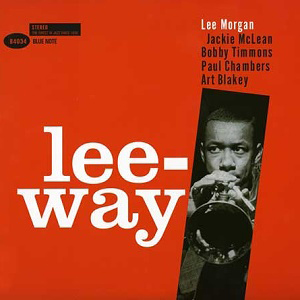
As you can see below, I have started to accumulate re-issues of classic jazz albums. In fact, what I am finding is that I prefer listening to small groups of instruments, such as jazz trios, quartets, and quintets, on LP, while I prefer CD/SACD with orchestral music.
So, I tried different settings, listened, and gathered spectra with our Audio Precision. Here are the results.
Because I had set the Phonomena to a 475 Ohm resistance and capacitance set to “Off” when I used the MT10 with its Clearaudio cartridge, I left the settings that way to begin with the VPI and Sumiko Blackbird cartridge.
Below is shown a spectrum with a 1 kHz sine wave input (using a test LP). The second harmonic is 47 dB below the fundamental. Also note the third and fourth harmonics. The upward slope in bass response is due to the application of the reverse RIAA curve (“De-emphasis”) in the phono preamp. This accentuates the low frequency surface noise, unfortunately, as well as delivers the proper curve to the LP recording.
For the distortion measurements, I used the input from a cartridge (Sumiko Blackbird) rather than generating test signals by the 2722 because I wanted an actual cartridge impedance to be placed on the phono preamp. The 2722 was used only for analyzing distortion from the phono preamp output. In the case of frequency response measurements, I used the 2722 to generate the signal (see below) as well as to analyze the output.
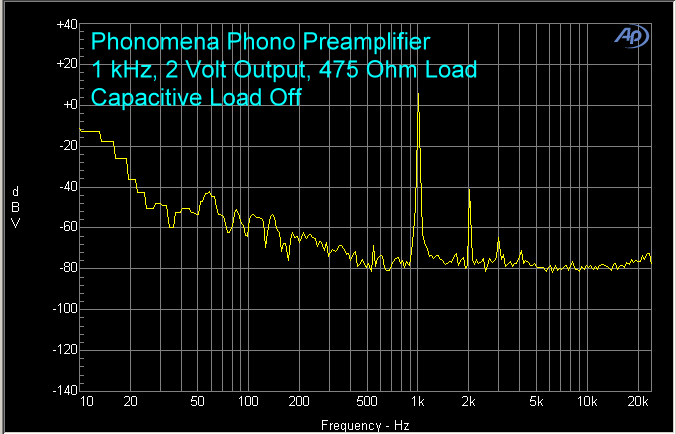
I then switched on the capacitive load, and gathered another spectrum, shown below.
What changed? Well, the second harmonic is now a little lower (49 dB below the fundamental), but the third harmonic is now a bit higher, the fourth is lower, and there are visible fifth and sixth harmonics. So, theoretically, the capacitive switch should be left in the off position.
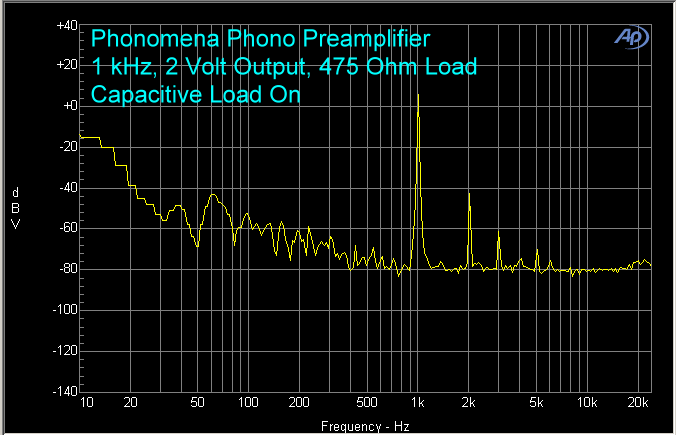
Setting the resistance to 50 kOhms (the impedance of the cartridge is 135 Ohms) yielded the following spectrum. It is more like the 475 Ohm capacitive “On” graph than the “Off” graph. Therefore, I would say that the 475 Ohm load, capacitive “Off” setting would be “technically” the best. Although audible differences were not apparent, I suspect that a consumer spending hours and hours on end listening to one vs. the other settings would eventually decide on one particular setting. Remember that the Off position for capacitive loading is 100 pF, while the On position is 200 pF.

Here is the Phonomena frequency response. For this test (on all three phono preamps), I used our Audio Precision to generate the sweep instead of using a sweep signal from an LP and cartridge. I set the input and gain to yield as near to 1 volt output at 1 kHz as possible, then ran the sweep, using a script that compared the preamp’s output with the standard RIAA de-emphasis curve. If the preamp’s RIAA algorithm corresponded perfectly with the standard curve, the result would be a flat line.
You can see that the Phonomena’s response is flat from 10 Hz all the way out to 30 kHz with only a tiny deviation here and there. Overall response is ± 0.1 dB. Superb.
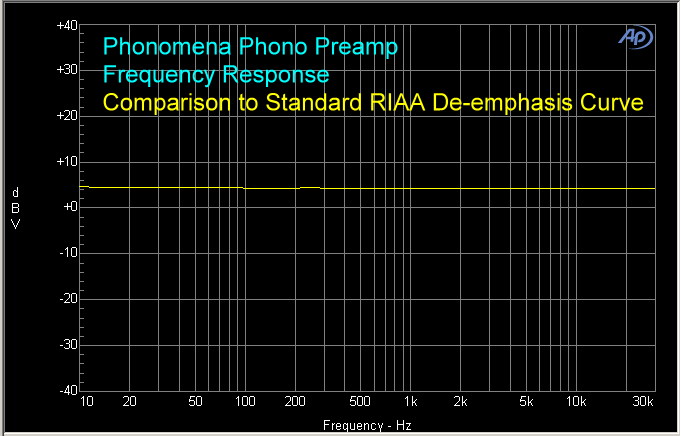
Shown below is the standard RIAA de-emphasis curve, to which the tested preamplifiers were compared. Basically what this means is that when a 10 Hz signal comes into the preamp, it (should) boost it by 20 dB, no boost at 1 kHz, and attenuates it by 20 dB at 20 kHz.

The Phonomena’s RIAA de-emphasis EQ was the flattest response measured in all three phono preamps tested, another reason the Phonomena is a bargain. As you will see though, the others did very well also, and the deviation from the standard curve was miniscule.
In any case, I really liked the Musical Surroundings Phonomena and would recommend it to anyone on a medium budget. We will get some of the truly inexpensive phono preamps ($150 – $300) as soon as possible to make comparisons.
The Bryston BP-1.5 phono preamplifier needs an outboard power supply. The good news is that if you have a Bryston BP-26 preamplifier, you already have the power supply that will drive the BP-1.5 phono preamp. In the photo below are the BP-1.5, then underneath that is the BP-26, and on the bottom is the power supply that drives them both. The rear panel actually has several outputs so you can power all sorts of Bryston products. The BP-1.5 is $1,800 USA not including the power supply, so it’s more expensive than the Phononema and less expensive than the Manley Steelhead. The photo below shows the BP-1.5 on top, the BP-26 in the middle, and the power supply on the bottom.

Here is a photo of the rear panel (click to enlarge it). You can see the dip switches on the right side.

The BP-1.5 has variable gain settings from 35 dB up to 63.5 dB, depending on whether you have set the front panel to MM or MC. For MM, capacitive loading ranges from Off to 188 pF. Resistance is not variable.
I listened to LPs (McIntosh MT10, VPI HR-X, Sumiko Blackbird) using the Bryston BP-26 and BP-1.5 combo (the BP-26 is an excellent preamp, as reported previously), but I compared the sound of the BP-1.5 using the same preamplifier (BAT VK-5i) that I used for the other two preamplifiers for consistency in this review.

The sound was very tight and had very low noise, with plenty of gain when it was needed (the MT10 cartridge only outputs 0.7 mV). By the way, the Art Pepper album shown in the photo is one of the best re-releases on LP that I have yet heard, out of about a dozen albums that I have purchased. This particular one is the 33-1/3 re-issue at $25. If you want it in the 45 RPM version (two LPs), the price is $100. That is a bit steep for me, but apparently there are some LP aficionados out there who are willing and able to shell it out. No question but that it is a terrific album though.
The 1 kHz sine wave test is shown below. Notice that the second and fourth harmonics predominate, with third and fifth almost non-existent. This is excellent performance
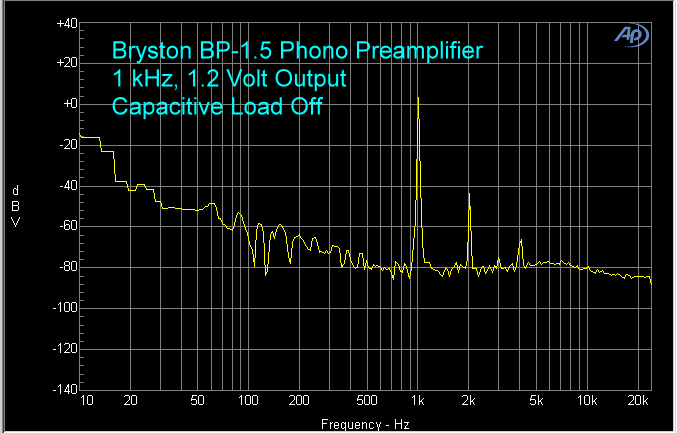
Here is the frequency response. The horizontal line is the comparison of the standard RIAA curve with the response of the BP-1.5. It is within ± 0.25 dB, 20 Hz – 20 kHz.
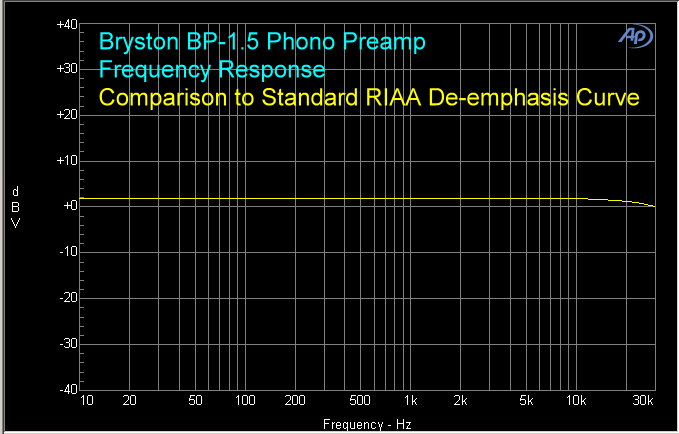
Now to the Manley Steelhead phono preamplifier.
I have known EveAnna Manley, chief honcho at Manley Labs for years, and she is really a special person. Let’s just say that you will never get bored when she is in the conversation. But more to the point, she manufactures terrific products: preamplifiers, amplifiers, microphones, and other things, including a Phono preamplifier. Her hi-fi components are named after fish, and this one is the Steelhead. In fact the air vents on the top of the chassis are shaped like a fish.
The Steelhead consists of two chassis, one of which is the power supply, and other being the control unit. Here is a photo of the front of the control unit with the power supply on top.
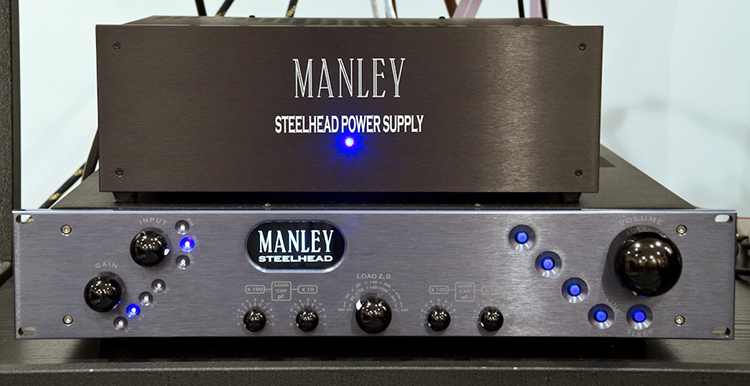
On the left are the Input Selector (two MC and one MM), the Gain (50 dB through 65 dB, then capacitive load selector for each channel and resistance selector in the middle. To be more precise, there is an autoformer for the MC inputs that provide impedance load matching for the MC cartridge, while the MM load dial provides purely resistive loading for MM cartridges.
For resistance, you can select up to 400 Ohms for MC (moving coil) inputs and up to 47 kOhms for the MM (moving magnet cartridge) input. Capacitance can be loaded up to 1,100 pF (or none at all). Then, Mute, Dim (turns down the volume for when you change the side of the LP or put on a different LP), Sum (mono), Line (connects an external line-level source), and Sleep (standby – which keeps the “logic” alive) buttons. The Mute light comes on when you first turn it on, and it has to be turned off manually to start playing music. The turn-on mute delay keeps power-on thumps from being amplified downstream.
The rear panel is shown below.

The Steelhead has two variable out jacks which are connected to the volume control on the front panel. This is for using the Steelhead to drive power amplifiers rather than going through another preamplifier. If you only are listening to LPs, this would work fine. However, if you want to go through your receiver or two-channel preamp where you also have a CD player, then you should use the fixed level output. Of course, you could do both, with the variable output going to a pair of power amplifiers, and the fixed output going to a separate preamplifier. One last possibility is to use one of the variable output sets to pad the volume of another preamplifier downstream so that the input signal for that second preamp is not too high.
On the other hand, there is also a Line In, so you could connect your CD player to that input, and use the Steelhead as your preamplifier. But, if you have a third source . . . .
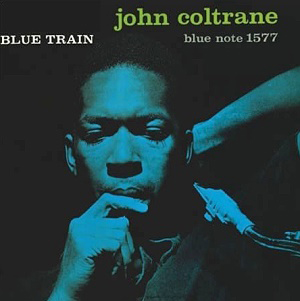
OK, I think you get the picture. The Steelhead is probably the most flexible phono stage in the world. It’s $7,300 and that is no chump change, but in my opinion, it is worth the hefty price (the Streelhead with its two chassis is a hefty product). It has up to 72 dB gain for the MC inputs, and up to 65 dB for the MM input, which is the highest gain spec of all the phono stages we have tested so far (granted, not very many, but 72 dB of gain is high in any comparison).
The multi-pin jack in the center of the rear panel is for connection to the separate power supply. You were also probably wondering about the RFI Shunt dip switches. Those are for a situation where you hear a radio station in the background for whatever reason (you might live near a radio station transmitter antenna for example). When you are trying to deal with a signal of less than a millivolt, this can happen.
The audio chassis contains two 6922 tubes and four 7044 tubes. The whole thing is quite heavy, more so than some receivers. Tubes need a lot of power, and analog power supplies weigh a lot more than switching power supplies.
For the tests, I used the VPI HR-X turntable and Sumiko cartridge, as I did with the Phonomena.
First, the Steelhead has more available gain, and therefore, can easily work with low output cartridges, such as the Clearaudio MC in the McIntosh MT10. For high output cartridges like the Sumiko Blackbird, the Steelhead just coasts along, using one of its lower gain stage settings. In this case, I used a mid-level gain setting to bring the output voltage as close to the 2 volt output I was getting with the Phonomena. It ended up being 1.8 volts. Here is the spectrum.
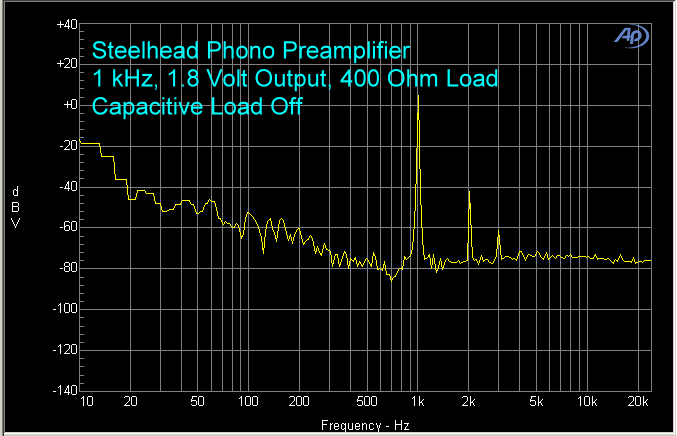
The second-order harmonic is a bit lower, and the third is a bit higher than with the Phonomena.
I did not test the Steelhead with any capacitive loading selected (this is primarily for MM cartridges).
The frequency response is shown below. The RIAA comparison with the standard curve indicates that the overall response is ± 0.25 dB throughout the audible band.
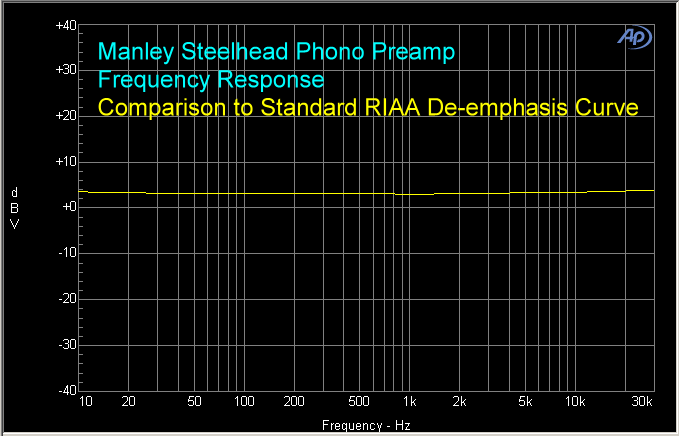
The Steelhead delivered plenty of volume, with clear highs and deep bass. I had no complaints at all. Because the Steelhead lets you add or subtract resistance and capacitive loading (I did not test the Steelhead with capacitive loading because this is primarily for MM cartridges), I adjusted the resistance while the music was playing and found that different settings gave tighter vs. more open sound. You really just have to try the settings out for yourself and decide what you like. In fact, you very well might like different settings for different albums or various types of music. I don’t know of any other phono preamp that offers this kind of flexibility.
I noticed that when playing jazz albums cut at 45 RPM, the sound from the Sumiko Blackbird was like the Clearaudio cartridge sounded at 33-1/3 RPM. The disadvantage of having albums at 45 RPM is that it takes two LPs instead of one, and this raises the price substantially ($50 instead of $30).
Frankly, I did not hear definitive differences between the Phonomena, BP-1.5, and Steelhead, but there are so many permutations that are possible with the settings, it is very difficult to compare them. All three sounded so good, I would be happy with any of them, but the output impedance and current drive available in the output stage of the Steelhead (the Steelhead has 350 Volt rails compared to low voltage rails in the Phonomena and BP-1.5, which means higher headroom and output capability) could be useful when you have to drive a difficult load. The large amount of gain capability in the Steelhead is essential if you need to amplify a low output cartridge, e.g., 0.7 mV. So, the Steelhead has the edge. Of course, the Steelhead is more expensive than the other two combined. Another problem in comparing the phono preamps is that the inherent high surface noise obscures the higher order harmonics that might distinguish them.
You can also change the resistance and capacitive loading while you are listening with the Steelhead, while with most other phono preamps, including the Phonomena and BP-1.5, you have to turn the preamp around and flip dip switches on the rear panel. Perhaps when we get some entry level phono preamplifiers, more clear differences will emerge. For now, all three of these products get my official approval.
I could hear more difference between 33-1/3 RPM and 45 RPM than I could between the three phono preamps listed here. It was mainly in the treble. The ride cymbals sounded more natural. Cleaner. More life. More of all the good adjectives. This is because the hills and valleys in the grooves of the LP are farther apart, so the stylus has an easier time tracking the fine detail of the high frequencies. However, 33-1/3 does still sound terrific. No two ways about it. I just wish the 45 RPM LPs were not so expensive. You might complain about $20 CDs. Well, how about $100 LPs!!!???
Following the completion of Part 8 of this treatise, the comment section became the largest set of remarks, questions, and hotly contested arguments we have yet seen here at Secrets. It kind of all boils down to how well a needle sliding through a vinyl valley can reproduce the original musical signal compared to a digital bitstream that represents samples taken during the music, and are used to reconstruct the musical signal.
I tested some 10 kHz and 20 kHz sine waves that were recorded at several word lengths (16 bit or 24 bit) and sampling frequencies (44.1 kHz, 96 kHz, 192 kHz), analyzing them in a software sequencer.
Here are the results.
Below is a graph, showing the fine detail of digital recordings made at 16/44, 16/96, 16/192, 24/44, 24/96, and 24/192 using a 10 kHz sine wave. I wanted to vary only the word length for the test, to show that any differences would be a result of the sampling frequency; otherwise there would be a compounding of variables. So, the sampling frequency graphs are shown both for 16 bit and 24 bit word lengths. From left to right, the plot spans 0.001 second, that is 1/1000th of a second. The dots on the graphs represent individual samples, so we are talking about really fine detail analysis here.
The dots represent finite voltage values that are fed in sequence as a stream to the DAC, which then produces a stair-stepped output, after which a low-pass reconstruction filter smooths out the signal. What I want you to notice is how jagged the lines are at standard Redbook CD 16/44. The DAC and reconstruction filter’s job is to make these jagged lines more sinusoidal, so that it will be like the music that was recorded, which is also sinusoidal.
There are various ways of applying filters, and we won’t get into that here, but I was really surprised at how poorly the 16/44 digital stream is representing the original 10 kHz sine wave. Notice that even at 16/96, the lines are not all that smooth. But, at 16/192, the sine wave looks very good. If we were observing a 10 kHz sine wave coming off an LP and displayed on an oscilloscope, it would be essentially sinusoidal, not jagged (it would not be perfectly smooth of course, as there would be at least a little distortion in the signal being played).
Click on the images (graphs) to make them larger, then use the slider on the right hand side to scroll the image, if necessary. Close the image by clicking on the X in the upper right hand corner.
Here is the 10 kHz graph.
Here is a graph of a 20 kHz sine wave recorded at 16/44, 24/96, and 24/192. You can see that, even at 24/192, the wave form is not smooth, so a reconstruction filter still has to be applied. Is it any wonder that the arguments about Vinyl vs. CD go on and on?


